Neil Gehrels–Swift Observatory’s Ultraviolet/Optical Telescope Observations of Small Bodies in the Solar System
Abstract
1. Introduction
2. Highlights
2.1. Large Spin-Down of Comet 41P/Tuttle–Giacobini–Kresák
2.2. Activity Evolution of Comets
2.3. Rapid Follow Up on Outburst and Fragmentation Events
2.4. Ultraviolet Spectroscopy of Asteroids
2.5. Grism Spectroscopy of Comets
2.6. Contemporaneous X-ray and UV Observations
3. Conclusions
Author Contributions
Funding
Data Availability Statement
Acknowledgments
Conflicts of Interest
| 1 | for example, observations with CSHELL at NASA-IRTF use a typical slit size of 1.0 × 30 arcsec, whereas UVOT’s FOV is 17 arcmin × 17 arcmin. |
| 2 | https://ssd.jpl.nasa.gov/horizons/, accessed on 1 December 2022. |
References
- Rubin, M.; Bekaert, D.V.; Broadley, M.W.; Drozdovskaya, M.N.; Wampfler, S.F. Volatile Species in Comet 67P/Churyumov-Gerasimenko: Investigating the Link from the ISM to the Terrestrial Planets. ACS Earth Space Chem. 2019, 3, 1792–1811. [Google Scholar] [CrossRef]
- Altwegg, K.; Team, R. Chemical highlights from the Rosetta mission. Astrochem. VII Through Cosm. Galaxies Planets 2018, 332, 153–162. [Google Scholar] [CrossRef]
- McKay, A.; Roth, N. Organic Matter in Cometary Environments. Life 2021, 11, 37. [Google Scholar] [CrossRef] [PubMed]
- Jewitt, D.; Hsieh, H.H. The Asteroid-Comet Continuum. arXiv 2022, arXiv:2203.01397. [Google Scholar]
- Snodgrass, C.; Tubiana, C.; Vincent, J.B.; Sierks, H.; Hviid, S.F.; Moissi, R.; Boehnhardt, H.; Barbieri, C.; Koschny, D.; Lamy, P.L.; et al. A collision in 2009 as the origin of the debris trail of asteroid P/2010A2. Nature 2010, 467, 814. [Google Scholar] [CrossRef]
- Bodewits, D.; Kelley, M.S.; Li, J.Y.; Landsman, W.B.; Besse, S.; A’Hearn, M.F. Collisional Excavation of Asteroid (596) Scheila. Astrophys. J. Lett. 2011, 733, L3. [Google Scholar] [CrossRef]
- Choukroun, M.; Altwegg, K.; Kührt, E.; Biver, N.; Bockelée-Morvan, D.; Drążkowska, J.; Hérique, A.; Hilchenbach, M.; Marschall, R.; Pätzold, M.; et al. Dust-to-Gas and Refractory-to-Ice Mass Ratios of Comet 67P/Churyumov-Gerasimenko from Rosetta Observations. Space Sci. Rev. 2020, 216, 44. [Google Scholar] [CrossRef]
- Hahn, G.; Rickman, H. Asteroids in cometary orbits. Icarus 1985, 61, 417–442. [Google Scholar] [CrossRef]
- Meech, K.J.; Yang, B.; Kleyna, J.; Hainaut, O.R.; Berdyugina, S.; Keane, J.V.; Micheli, M.; Morbidelli, A.; Wainscoat, R.J. Inner solar system material discovered in the Oort cloud. Sci. Adv. 2016, 2, e1600038. [Google Scholar] [CrossRef]
- Gehrels, N.; Chincarini, G.; Giommi, P.; Mason, K.O.; Nousek, J.A.; Wells, A.A.; White, N.E.; Barthelmy, S.D.; Burrows, D.N.; Cominsky, L.R.; et al. The Swift Gamma-Ray Burst Mission. Astrophys. J. 2004, 611, 1005–1020. [Google Scholar] [CrossRef]
- Roming, P.W.A.; Kennedy, T.E.; Mason, K.O.; Nousek, J.A.; Ahr, L.; Bingham, R.E.; Broos, P.S.; Carter, M.J.; Hancock, B.K.; Huckle, H.E.; et al. The Swift Ultra-Violet/Optical Telescope. Space Sci. Rev. 2005, 120, 95–142. [Google Scholar] [CrossRef]
- Mason, K.O.; Breeveld, A.; Hunsberger, S.D.; James, C.; Kennedy, T.E.; Roming, P.W.A.; Stock, J. Performance of the UV/Optical Telescope (UVOT) on SWIFT. X-ray Gamma-Ray Instrum. Astron. XIII 2004, 5165, 277–286. [Google Scholar] [CrossRef]
- Breeveld, A.A.; Curran, P.A.; Hoversten, E.A.; Koch, S.; Landsman, W.B.; Marshall, F.E.; Page, M.J.; Poole, T.S.; Roming, P.W.A.; Smith, P.J.; et al. Further calibration of the Swift ultraviolet/optical telescope. Mon. Not. R. Astron. Soc. 2010, 406, 1687–1700. [Google Scholar] [CrossRef]
- Kuin, N.P.M.; Landsman, W.B.; Breeveld, A.A.; Page, M.J.; Lamoureux, H.; James, C.; Mehdipour, M.; Still, M.; Yershov, V.; Brown, P.J.; et al. Calibration of the Swift-UVOT ultraviolet and visible grisms. Mon. Not. R. Astron. Soc. 2015, 449, 2514–2538. [Google Scholar] [CrossRef]
- Fordham, J.L.A.; Moorhead, C.F.; Galbraith, R.F. Dynamic-range limitations of intensified CCD photon-counting detectors. Mon. Not. R. Astron. Soc. 2000, 312, 83–88. [Google Scholar] [CrossRef]
- Bodewits, D.; Farnham, T.L.; A’Hearn, M.F.; Feaga, L.M.; McKay, A.J.; Schleicher, D.G.; Sunshine, J.M. The Evolving Activity of the Dynamically Young Comet C/2009 P1 (Garradd). Astrophys. J. 2014, 786, 48. [Google Scholar] [CrossRef]
- Xing, Z.; Bodewits, D.; Noonan, J.; Bannister, M.T. Water Production Rates and Activity of Interstellar Comet 2I/Borisov. Astrophys. J. Lett. 2020, 893, L48. [Google Scholar] [CrossRef]
- Villanueva, G.L.; Smith, M.D.; Protopapa, S.; Faggi, S.; Mandell, A.M. Planetary Spectrum Generator: An accurate online radiative transfer suite for atmospheres, comets, small bodies and exoplanets. J. Quant. Spectrosc. Radiat. Transf. 2018, 217, 86–104. [Google Scholar] [CrossRef]
- Combi, M.R.; Mäkinen, T.; Bertaux, J.L.; Quémerais, E.; Ferron, S.; Coronel, R. Comet 41P/Tuttle–Giacobini–Kresak, 45P/Honda–Mrkos–Pajdusakova, and 46P/Wirtanen: Water Production Activity over 21 yr with SOHO/SWAN. Planet. Sci. J. 2020, 1, 72. [Google Scholar] [CrossRef]
- Bodewits, D.; Farnham, T.L.; Kelley, M.S.; Knight, M.M. A rapid decrease in the rotation rate of comet 41P/Tuttle–Giacobini–Kresák. Nature 2018, 553, 186–188. [Google Scholar] [CrossRef]
- Schleicher, D.G.; Knight, M.M.; Eisner, N.L.; Thirouin, A. Gas Jet Morphology and the Very Rapidly Increasing Rotation Period of Comet 41P/Tuttle-Giacobini-Kresák. Astron. J. 2019, 157, 108. [Google Scholar] [CrossRef]
- Moulane, Y.; Jehin, E.; Opitom, C.; Pozuelos, F.J.; Manfroid, J.; Benkhaldoun, Z.; Daassou, A.; Gillon, M. Monitoring of the activity and composition of comets 41P/Tuttle–Giacobini–Kresak and 45P/Honda–Mrkos–Pajdusakova. Astron. Astrophys. 2018, 619, A156. [Google Scholar] [CrossRef]
- Farnham, T.L.; Kelley, M.S.P.; Bodewits, D.; Knight, M.M.; Thirouin, A.; Moskovitz, N. Comet 41P/Tuttle–Giacobini–Kresák; CBET: San Antonio, TX, USA, 2017; Volume 4375. [Google Scholar]
- Keller, H.U.; Mottola, S.; Skorov, Y.; Jorda, L. The changing rotation period of comet 67P/Churyumov-Gerasimenko controlled by its activity. Astron. Astrophys. 2015, 579, L5. [Google Scholar] [CrossRef]
- Gutiérrez, P.J.; Jorda, L.; Gaskell, R.W.; Davidsson, B.J.R.; Capanna, C.; Hviid, S.F.; Keller, H.U.; Maquet, L.; Mottola, S.; Preusker, F.; et al. Possible interpretation of the precession of comet 67P/Churyumov-Gerasimenko. Astron. Astrophys. 2016, 590, A46. [Google Scholar] [CrossRef]
- Gutiérrez, P.J.; Jorda, L.; Ortiz, J.L.; Rodrigo, R. Long-term simulations of the rotational state of small irregular cometary nuclei. Astron. Astrophys. 2003, 406, 1123–1133. [Google Scholar] [CrossRef]
- Knight, M.M.; Eisner, N.; Schleicher, D.G.; Thirouin, A. Comet 41P/Tuttle–Giacobini–Kresák; CBET: San Antonio, TX, USA, 2017; Volume 4377. [Google Scholar]
- Keller, H.U.; Kührt, E. Cometary Nuclei—From Giotto to Rosetta. Space Sci. Rev. 2020, 216, 14–26. [Google Scholar] [CrossRef]
- A’Hearn, M.F. Comets: Looking ahead. Philos. Trans. R. Soc. Lond. Ser. A 2017, 375, 20160261. [Google Scholar] [CrossRef]
- Ciarniello, M.; Fulle, M.; Raponi, A.; Filacchione, G.; Capaccioni, F.; Rotundi, A.; Rinaldi, G.; Formisano, M.; Magni, G.; Tosi, F.; et al. Macro and micro structures of pebble-made cometary nuclei reconciled by seasonal evolution. Nat. Astron. 2022, 6, 546–553. [Google Scholar] [CrossRef]
- Protopapa, S.; Kelley, M.S.P.; Yang, B.; Bauer, J.M.; Kolokolova, L.; Woodward, C.E.; Keane, J.V.; Sunshine, J.M. Icy Grains from the Nucleus of Comet C/2013 US10 (Catalina). Astrophys. J. Lett. 2018, 862, L16. [Google Scholar] [CrossRef]
- A’Hearn, M.F.; Belton, M.J.S.; Delamere, W.A.; Feaga, L.M.; Hampton, D.; Kissel, J.; Klaasen, K.P.; McFadden, L.A.; Meech, K.J.; Melosh, H.J.; et al. EPOXI at Comet Hartley 2. Science 2011, 332, 1396–1400. [Google Scholar] [CrossRef]
- Bonev, B.P.; Dello Russo, N.; DiSanti, M.A.; Martin, E.C.; Doppmann, G.; Vervack Ronald, J.J.; Villanueva, G.L.; Kawakita, H.; Gibb, E.L.; Combi, M.R.; et al. First Comet Observations with NIRSPEC-2 at Keck: Outgassing Sources of Parent Volatiles and Abundances Based on Alternative Taxonomic Compositional Baselines in 46P/Wirtanen. Planet. Sci. J. 2021, 2, 45. [Google Scholar] [CrossRef]
- Capria, M.T.; Capaccioni, F.; Filacchione, G.; Tosi, F.; De Sanctis, M.C.; Mottola, S.; Ciarniello, M.; Formisano, M.; Longobardo, A.; Migliorini, A.; et al. How pristine is the interior of the comet 67P/Churyumov-Gerasimenko? Mon. Not. R. Astron. Soc. 2017, 469, S685–S694. [Google Scholar] [CrossRef]
- Biver, N.; Dello Russo, N.; Opitom, C.; Rubin, M. Chemistry of comet atmospheres. arXiv 2022, arXiv:2207.04800. [Google Scholar]
- A’Hearn, M.F.; Millis, R.L.; Schleicher, D.G.; Osip, D.J.; Birch, P.V. The ensemble properties of comets: Results from narrowband photometry of 85 comets, 1976-1992. Icarus 1995, 118, 223. [Google Scholar] [CrossRef]
- Carter, J.A.; Bodewits, D.; Read, A.M.; Immler, S.M. Simultaneous Swift X-ray and UV views of comet C/2007 N3 (Lulin). Astron. Astrophys. 2012, 541, 70. [Google Scholar] [CrossRef]
- Farnham, T.L.; Schleicher, D.G.; A’Hearn, M.F. The HB Narrowband Comet Filters: Standard Stars and Calibrations. Icarus 2000, 147, 180. [Google Scholar] [CrossRef]
- Paganini, L.; Mumma, M.J.; Villanueva, G.L.; DiSanti, M.A.; Bonev, B.P.; Lippi, M.; Boehnhardt, H. The Chemical Composition of CO-rich Comet C/2009 P1 (Garradd) AT R h = 2.4 and 2.0 AU before Perihelion. Astrophys. J. Lett. 2012, 748, L13. [Google Scholar] [CrossRef]
- DiSanti, M.A.; Villanueva, G.L.; Paganini, L.; Bonev, B.P.; Keane, J.V.; Meech, K.J.; Mumma, M.J. Pre- and post-perihelion observations of C/2009 P1 (Garradd): Evidence for an oxygen-rich heritage? Icarus 2014, 228, 167–180. [Google Scholar] [CrossRef][Green Version]
- Villanueva, G.L.; Mumma, M.J.; DiSanti, M.A.; Bonev, B.P.; Paganini, L.; Blake, G.A. A multi-instrument study of Comet C/2009 P1 (Garradd) at 2.1 AU (pre-perihelion) from the Sun. Icarus 2012, 220, 291–295. [Google Scholar] [CrossRef]
- Combi, M.R.; Mäkinen, J.T.T.; Bertaux, J.L.; Quémerais, E.; Ferron, S.; Fougere, N. Water production rate of Comet C/2009 P1 (Garradd) throughout the 2011-2012 apparition: Evidence for an icy grain halo. Icarus 2013, 225, 740–748. [Google Scholar] [CrossRef]
- Jewitt, D.; Luu, J. Initial Characterization of Interstellar Comet 2I/2019 Q4 (Borisov). Astrophys. J. Lett. 2019, 886, L29. [Google Scholar] [CrossRef]
- Bodewits, D.; Noonan, J.W.; Feldman, P.D.; Bannister, M.T.; Farnocchia, D.; Harris, W.M.; Li, J.Y.; Mandt, K.E.; Parker, J.W.; Xing, Z.X. The carbon monoxide-rich interstellar comet 2I/Borisov. Nat. Astron. 2020, 4, 867–871. [Google Scholar] [CrossRef]
- Cordiner, M.A.; Milam, S.N.; Biver, N.; Bockelee-Morvan, D.; Roth, N.X.; Bergin, E.A.; Jehin, E.; Remijan, A.J.; Charnley, S.B.; Mumma, M.J.; et al. Unusually high CO abundance of the first active interstellar comet. Nat. Astron. 2020, 1–6. [Google Scholar] [CrossRef]
- Lin, Z.Y.; Lin, C.S.; Ip, W.H.; Lara, L.M. The Outburst of Comet 17p/Holmes. Astron. J. 2009, 138, 625–632. [Google Scholar] [CrossRef]
- Pajola, M.; Höfner, S.; Vincent, J.B.; Oklay, N.; Scholten, F.; Preusker, F.; Mottola, S.; Naletto, G.; Fornasier, S.; Lowry, S.; et al. The pristine interior of comet 67P revealed by the combined Aswan outburst and cliff collapse. Nat. Astron. 2017, 1, 0092. [Google Scholar] [CrossRef]
- Reach, W.T.; Vaubaillon, J.; Kelley, M.S.; Lisse, C.M.; Sykes, M.V. Distribution and properties of fragments and debris from the split Comet 73P/Schwassmann-Wachmann 3 as revealed by Spitzer Space Telescope. Icarus 2009, 203, 571–588. [Google Scholar] [CrossRef]
- Farnham, T.L.; Schleicher, D.G.; Woodney, L.M.; Birch, P.V.; Eberhardy, C.A.; Levy, L. Imaging and Photometry of Comet C/1999 S4 (LINEAR) Before Perihelion and After Breakup. Science 2001, 292, 1348–1353. [Google Scholar] [CrossRef][Green Version]
- Hsieh, H.H.; Jewitt, D. A Population of Comets in the Main Asteroid Belt. Science 2006, 312, 561–563. [Google Scholar] [CrossRef]
- Larson, S.M. (596) Scheila. IAU Circ. 2010, 9188, 1. [Google Scholar]
- Jewitt, D.; Weaver, H.A.; Mutchler, M.J.; Larson, S.M.; Agarwal, J. Hubble Space Telescope Observations of Main-belt Comet (596) Scheila. Astrophys. J. Lett. 2011, 733, L4. [Google Scholar] [CrossRef]
- Ishiguro, M.; Hanayama, H.; Hasegawa, S.; Sarugaku, Y.; Watanabe, J.i.; Fujiwara, H.; Terada, H.; Hsieh, H.H.; Vaubaillon, J.J.; Kawai, N.; et al. Interpretation of (596) Scheila’s Triple Dust Tails. Astrophys. J. Lett. 2011, 741, L24. [Google Scholar] [CrossRef]
- Moreno, F.; Licandro, J.; Ortiz, J.L.; Lara, L.M.; Alí-Lagoa, V.; Vaduvescu, O.; Morales, N.; Molina, A.; Lin, Z.Y. (596) Scheila in Outburst: A Probable Collision Event in the Main Asteroid Belt. Astrophys. J. 2011, 738, 130. [Google Scholar] [CrossRef]
- Bodewits, D.; Vincent, J.B.; Kelley, M.S. Scheila’s scar: Direct evidence of impact surface alteration on a primitive asteroid. Icarus 2014, 229, 190–195. [Google Scholar] [CrossRef][Green Version]
- Gaffey, M.J. Space weathering and the interpretation of asteroid reflectance spectra. Icarus 2010, 209, 564–574. [Google Scholar] [CrossRef]
- Clark, B.E.; Binzel, R.P.; Howell, E.S.; Cloutis, E.A.; Ockert-Bell, M.; Christensen, P.; Barucci, M.A.; DeMeo, F.; Lauretta, D.S.; Connolly, H.; et al. Asteroid (101955) 1999 RQ36: Spectroscopy from 0.4 to 2.4 μm and meteorite analogs. Icarus 2011, 216, 462–475. [Google Scholar] [CrossRef]
- Cloutis, E.A.; McCormack, K.A.; Bell, J.F.; Hendrix, A.R.; Bailey, D.T.; Craig, M.A.; Mertzman, S.A.; Robinson, M.S.; Riner, M.A. Ultraviolet spectral reflectance properties of common planetary minerals. Icarus 2008, 197, 321–347. [Google Scholar] [CrossRef]
- Hendrix, A.R.; Vilas, F. C-Complex Asteroids: UV-Visible Spectral Characteristics and Implications for Space Weathering Effects. Geophys. Res. Lett. 2019, 46, 14307–14317. [Google Scholar] [CrossRef]
- Vilas, F.; Hendrix, A.R. The UV/Blue Effects of Space Weathering Manifested in S-Complex Asteroids. I. Quantifying Change with Asteroid Age. Astron. J. 2015, 150, 64. [Google Scholar] [CrossRef][Green Version]
- Butterworth, P.S.; Meadows, A.J.; Hunt, G.E.; Moore, V.; Willis, D.M. Ultraviolet spectra of asteroids. Nature 1980, 287, 701–703. [Google Scholar] [CrossRef]
- Butterworth, P.; Meadows, A. Ultraviolet reflectance properties of asteroids. Icarus 1985, 62, 305–318. [Google Scholar] [CrossRef]
- Roettger, E.E.; Buratti, B.J. Ultraviolet Spectra and Geometric Albedos of 45 Asteroids. Icarus 1994, 112, 496–512. [Google Scholar] [CrossRef]
- A’Hearn, M.F.; Feaga, L.M.; Bertaux, J.L.; Feldman, P.D.; Parker, J.W.; Slater, D.C.; Steffl, A.J.; Alan Stern, S.; Throop, H.; Versteeg, M.; et al. The far-ultraviolet albedo of Šteins measured with Rosetta-ALICE. Planet. Space Sci. 2010, 58, 1088–1096. [Google Scholar] [CrossRef]
- Stern, S.A.; Parker, J.W.; Feldman, P.D.; Weaver, H.A.; Steffl, A.; A’Hearn, M.F.; Feaga, L.; Birath, E.; Graps, A.; Bertaux, J.L.; et al. Ultraviolet discoveries at asteroid (21) lutetia by the rosetta alice ultraviolet spectrograph. Astron. J. 2011, 141, 199. [Google Scholar] [CrossRef]
- Li, J.Y.; Bodewits, D.; Feaga, L.M.; Landsman, W.; A’Hearn, M.F.; Mutchler, M.J.; Russell, C.T.; McFadden, L.A.; Raymond, C.A. Ultraviolet spectroscopy of Asteroid (4) Vesta. Icarus 2011, 216, 640–649. [Google Scholar] [CrossRef]
- Becker, T.M.; Cunningham, N.; Molyneux, P.; Roth, L.; Feaga, L.M.; Retherford, K.D.; Landsman, Z.A.; Peavler, E.; Elkins-Tanton, L.T.; Walhund, J.E. HST UV Observations of Asteroid (16) Psyche. Planet. Sci. J. 2020, 1, 53. [Google Scholar] [CrossRef]
- Xu, S.; Binzel, R.P.; Burbine, T.H.; Bus, S.J. Small Main-belt Asteroid Spectroscopic Survey: Initial results. Icarus 1995, 115, 1–35. [Google Scholar] [CrossRef]
- Bus, S.J.; Binzel, R.P. Phase II of the Small Main-Belt Asteroid Spectroscopic Survey. A Feature-Based Taxonomy. Icarus 2002, 158, 146–177. [Google Scholar] [CrossRef]
- Bodewits, D.; Villanueva, G.L.; Mumma, M.J.; Landsman, W.B.; Carter, J.A.; Read, A.M. SWIFT-UVOT Grism spectroscopy of comets: A first application TO C/2007 N3 (LULIN). Astron. J. 2011, 141, 12. [Google Scholar] [CrossRef][Green Version]
- Bohlin, R.C. Hubble Space Telescope Spectrophotometry and Models for Solar Analogs. Astron. J. 2010, 139, 1515–1520. [Google Scholar] [CrossRef]
- Morgenthaler, J.P.; Harris, W.M.; Combi, M.R.; Feldman, P.D.; Weaver, H.A. Galex Fuv Observations of Comet C/2004 Q2 (Machholz): The Ionization Lifetime of Carbon. Astrophys. J. 2011, 726, 8. [Google Scholar] [CrossRef]
- Feldman, P.D.; Cochran, A.L.; Combi, M.R. Spectroscopic Investigations of Fragment Species in the Coma; Comets II; University of Arizona Press: Tucson, AZ, USA, 2004; p. 425. [Google Scholar]
- Bodewits, D.; Bonev, B.P.; Cordiner, M.A.; Villanueva, G.L. Radiative processes as diagnostics of cometary atmospheres. arXiv 2022, arXiv:2209.02616. [Google Scholar]
- Willingale, R.; O’Brien, P.T.; Cowley, S.W.H.; Jones, G.H.; McComas, D.J.; Mason, K.O.; Osborne, J.P.; Wells, A.; Chester, M.; Hunsberger, S.; et al. Swift X-Ray Telescope Observations of the Deep Impact Collision. Astrophys. J. 2006, 649, 541–552. [Google Scholar] [CrossRef][Green Version]
- Bonamente, E.; Christian, D.J.; Xing, Z.; Venkataramani, K.; Koutroumpa, D.; Bodewits, D. Variable X-ray Emission of Comet 46P/Wirtanen. Planet. Sci. J. 2021, 2, 224. [Google Scholar] [CrossRef]
- Cravens, T.E. Comet Hyakutake x-ray source: Charge transfer of solar wind heavy ions. Geophys. Res. Lett. 1997, 24, 105. [Google Scholar] [CrossRef]
- Krasnopolsky, V.A. On the Nature of Soft X-Ray Radiation in Comets. Icarus 1997, 128, 368. [Google Scholar] [CrossRef]
- Lisse, C.M.; Dennerl, K.; Englhauser, J.; Harden, M.; Marshall, F.E.; Mumma, M.J.; Petre, R.; Pye, J.P.; Ricketts, M.J.; Schmitt, J.; et al. Discovery of X-ray and Extreme Ultraviolet Emission from Comet C/Hyakutake 1996 B2. Science 1996, 274, 205–209. [Google Scholar] [CrossRef]
- Bodewits, D.; Christian, D.J.; Torney, M.; Dryer, M.; Lisse, C.M.; Dennerl, K.; Zurbuchen, T.H.; Wolk, S.J.; Tielens, A.G.G.M.; Hoekstra, R. Spectral analysis of the Chandra comet survey. Astron. Astrophys. 2007, 469, 1183–1195. [Google Scholar] [CrossRef]
- Krasnopolsky, V.A. CXO X-ray spectroscopy of comets and abundances of heavy ions in the solar wind. Icarus 2015, 247, 95–102. [Google Scholar] [CrossRef]
- Kharchenko, V.; Rigazio, M.; Dalgarno, A.; Krasnopolsky, V.A. Charge Abundances of the Solar Wind Ions Inferred from Cometary X-Ray Spectra. Astrophys. J. 2003, 585, L73. [Google Scholar] [CrossRef]
- Bodewits, D.; Juhász, Z.; Hoekstra, R.; Tielens, A.G.G.M. Catching Some Sun: Probing the Solar Wind with Cometary X-Ray and Far-Ultraviolet Emission. Astrophys. J. Lett. 2004, 606, L81–L84. [Google Scholar] [CrossRef]
- Beiersdorfer, P.; Boyce, K.R.; Brown, G.V.; Chen, H.; Kahn, S.M.; Kelley, R.L.; May, M.; Olson, R.E.; Porter, F.S.; Stahle, C.K.; et al. Laboratory Simulation of Charge Exchange-Produced X-ray Emission from Comets. Science 2003, 300, 1558–1559. [Google Scholar] [CrossRef] [PubMed]
- Wegmann, R.; Dennerl, K. X-ray tomography of a cometary bow shock. Astron. Astrophys. 2005, 430, L33–L36. [Google Scholar] [CrossRef]
- Lisse, C.; Christian, D.; Dennerl, K.; Englhauser, J.; Trümper, J.; Desch, M.; Marshall, F.; Petre, R.; Snowden, S. X-Ray and Extreme Ultraviolet Emission from Comet P/Encke 1997. Icarus 1999, 141, 316–330. [Google Scholar] [CrossRef][Green Version]
- Wolk, S.J.; Lisse, C.M.; Bodewits, D.; Christian, D.J.; Dennerl, K. Chandra’S Close Encounter With The Disintegrating Comets 73p/2006 (Schwassmann-Wachmann 3) Fragment B In addition, C/1999 S4 (Linear). Astrophys. J. 2009, 694, 1293–1308. [Google Scholar] [CrossRef]
- Mullen, P.D.; Cumbee, R.S.; Lyons, D.; Gu, L.; Kaastra, J.; Shelton, R.L.; Stancil, P.C. Line Ratios for Solar Wind Charge Exchange with Comets. Astrophys. J. 2017, 844, 7. [Google Scholar] [CrossRef]
- Burrows, D.N.; Hill, J.E.; Nousek, J.A.; Wells, A.A.; Short, A.D.; Willingale, R.; Citterio, O.; Chincarini, G.; Tagliaferri, G. Swift X-ray Telescope. In Proceedings of the X-ray and Gamma-Ray Instrumentation for Astronomy XI, San Diego, CA, USA, 30 July–4 August 2000; Flanagan, K.A., Siegmund, O.H., Eds.; Society of Photo-Optical Instrumentation Engineers (SPIE) Conference Series. Volume 4140, pp. 64–75. [Google Scholar] [CrossRef]
- A’Hearn, M.F.; Belton, M.J.S.; Delamere, A.A.; Kissel, J.; Klaasen, K.P.; McFadden, L.A.; Meech, K.J.; Melosh, H.J.; Schultz, P.H.; Sunshine, J.M.; et al. Deep Impact: Excavating Comet Tempel 1. Science 2005, 310, 258–264. [Google Scholar] [CrossRef] [PubMed]
- Mason, K.; Chester, M.; Cucchiara, A.; Gronwall, C.; Grupe, D.; Hunsberger, S.; Jones, G.; Koch, S.; Nousek, J.; O’Brien, P.; et al. Swift ultraviolet photometry of the Deep Impact encounter with Comet 9P/Tempel 1. Icarus 2007, 187, 123–131. [Google Scholar] [CrossRef]
- A’Hearn, M.F. Deep Impact and the Origin and Evolution of Cometary Nuclei. Space Sci. Rev. 2008, 138, 237–246. [Google Scholar] [CrossRef]
- Lisse, C.; Dennerl, K.; Christian, D.; Wolk, S.; Bodewits, D.; Zurbuchen, T.; Hansen, K.; Hoekstra, R.; Combi, M.; Fry, C.; et al. Chandra observations of Comet 9P/Tempel 1 during the Deep Impact campaign. Icarus 2007, 191, 295–309. [Google Scholar] [CrossRef]
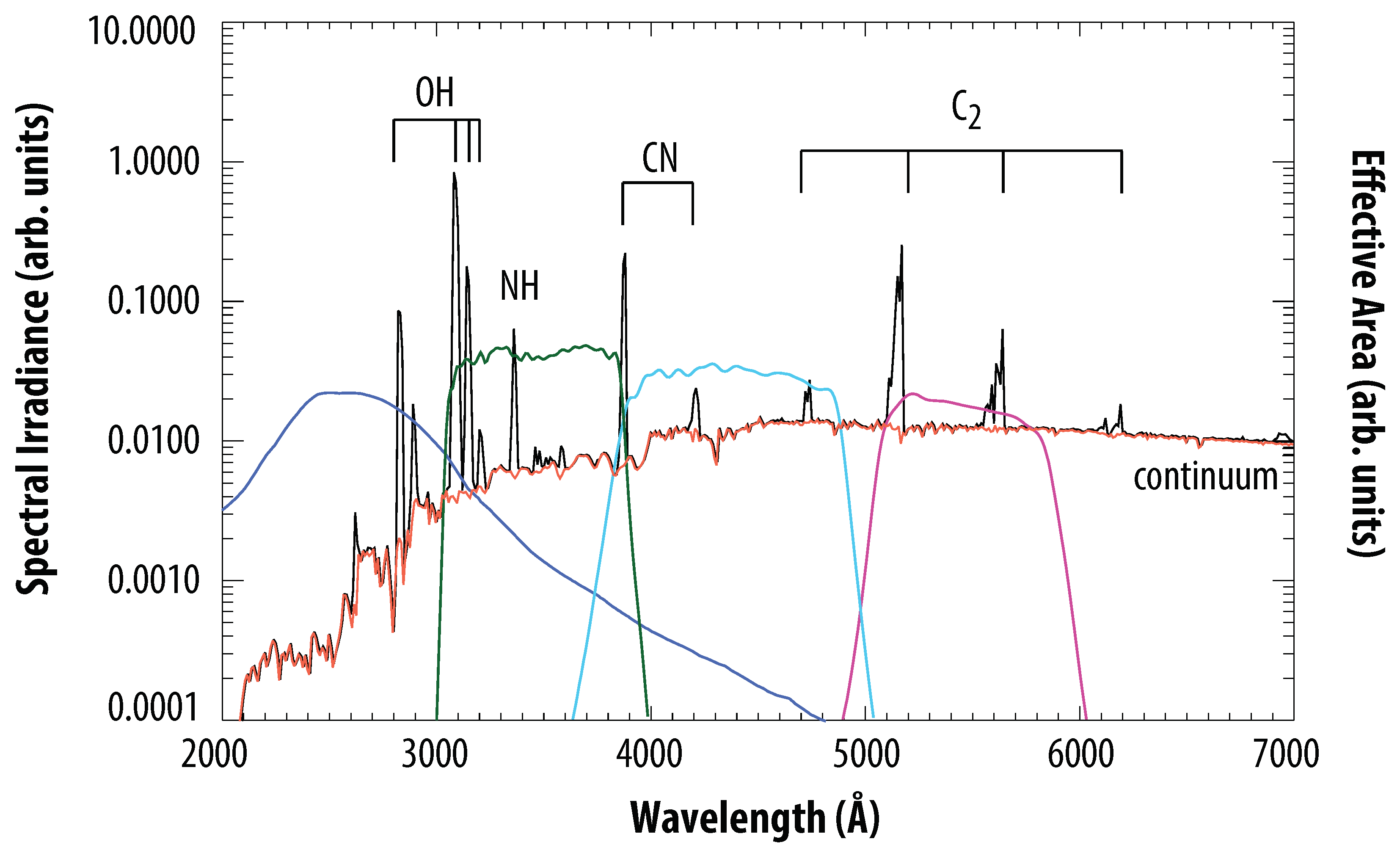
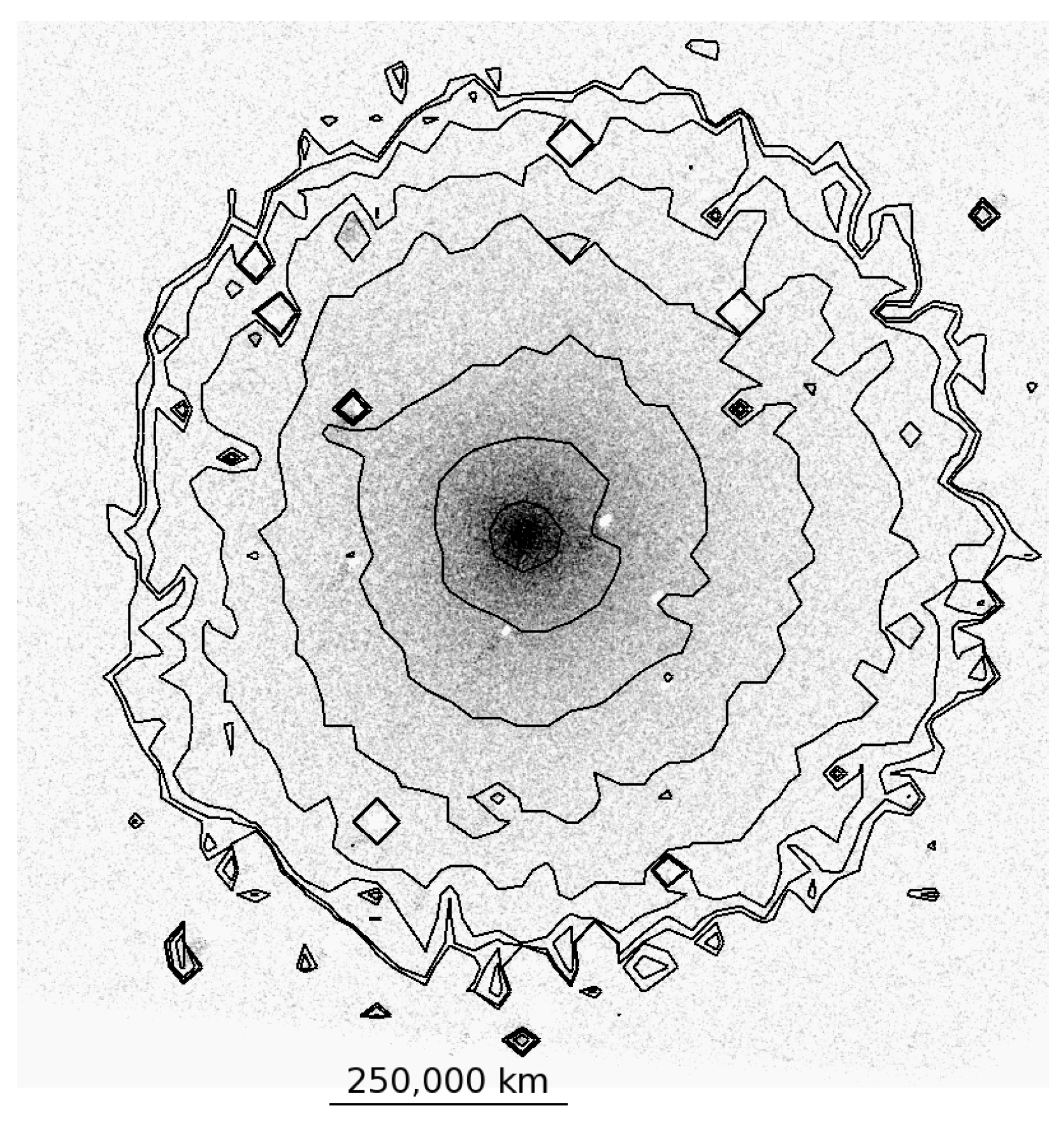
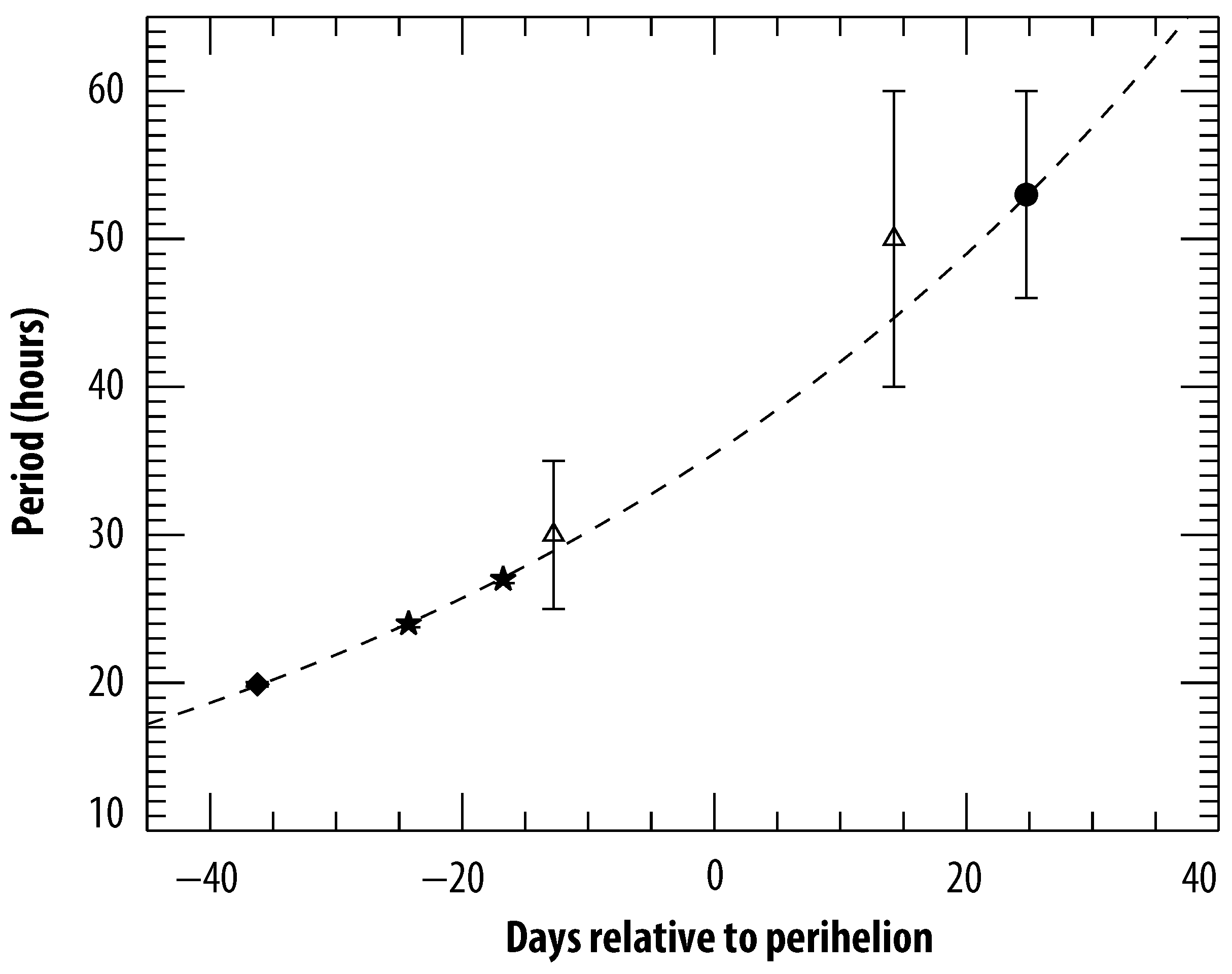
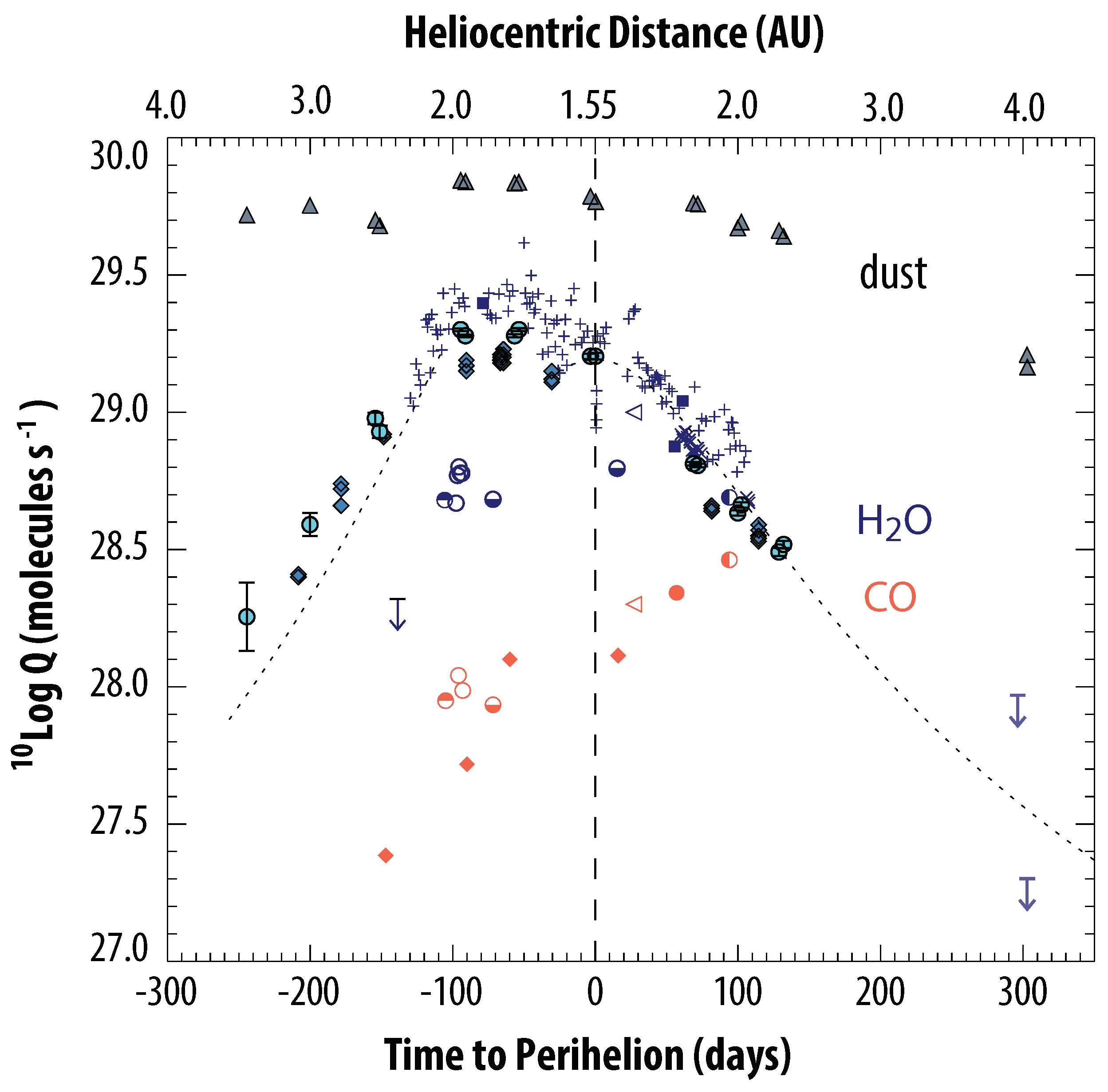
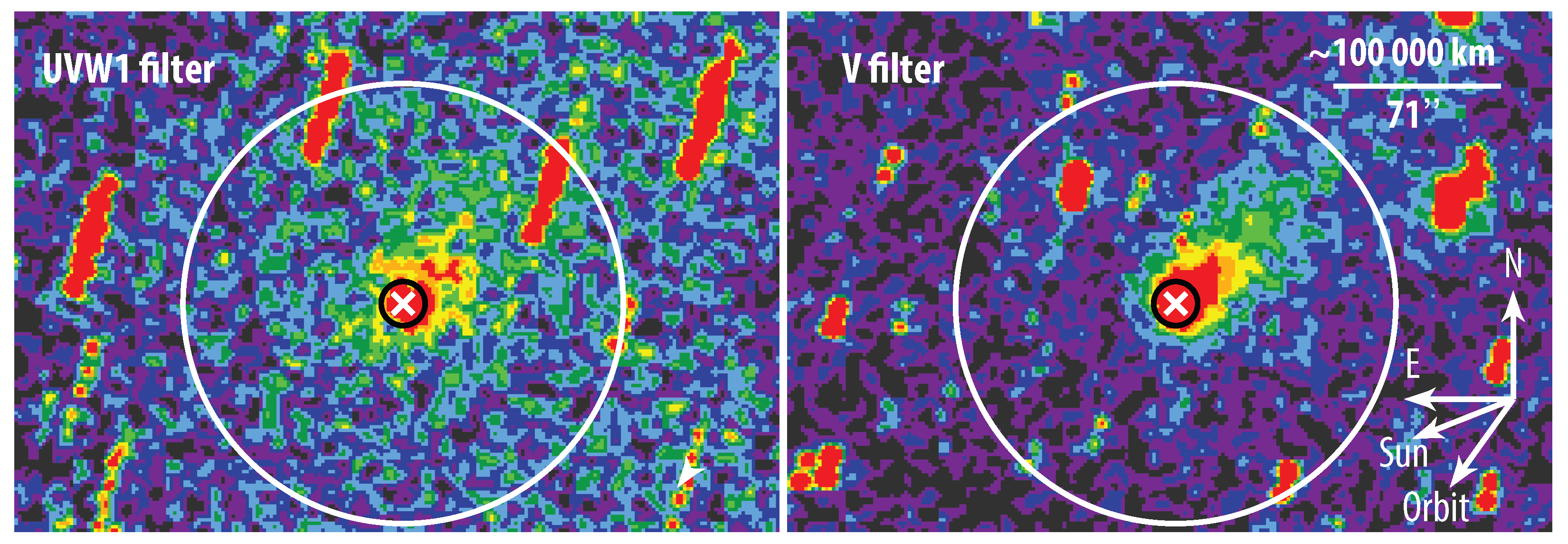
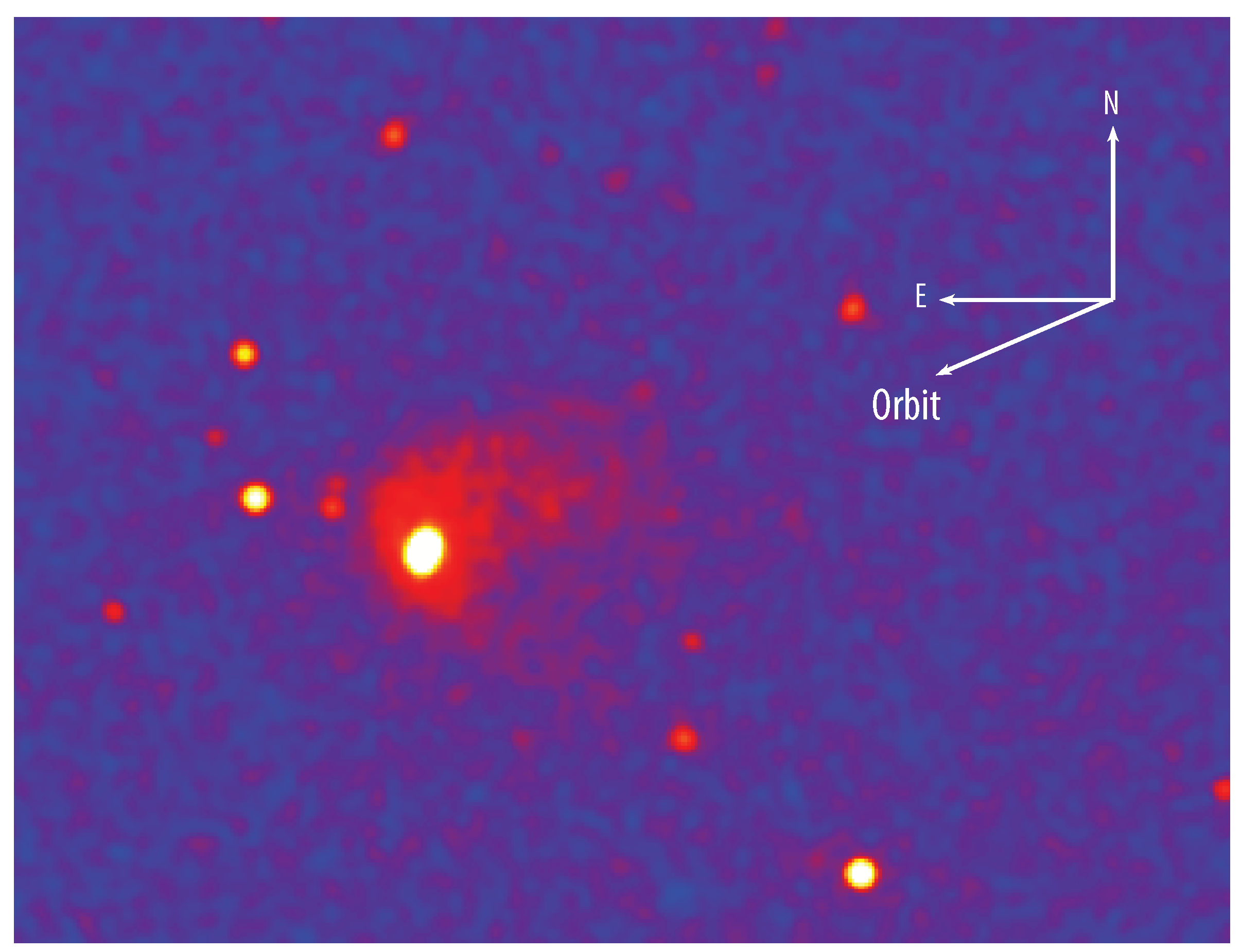
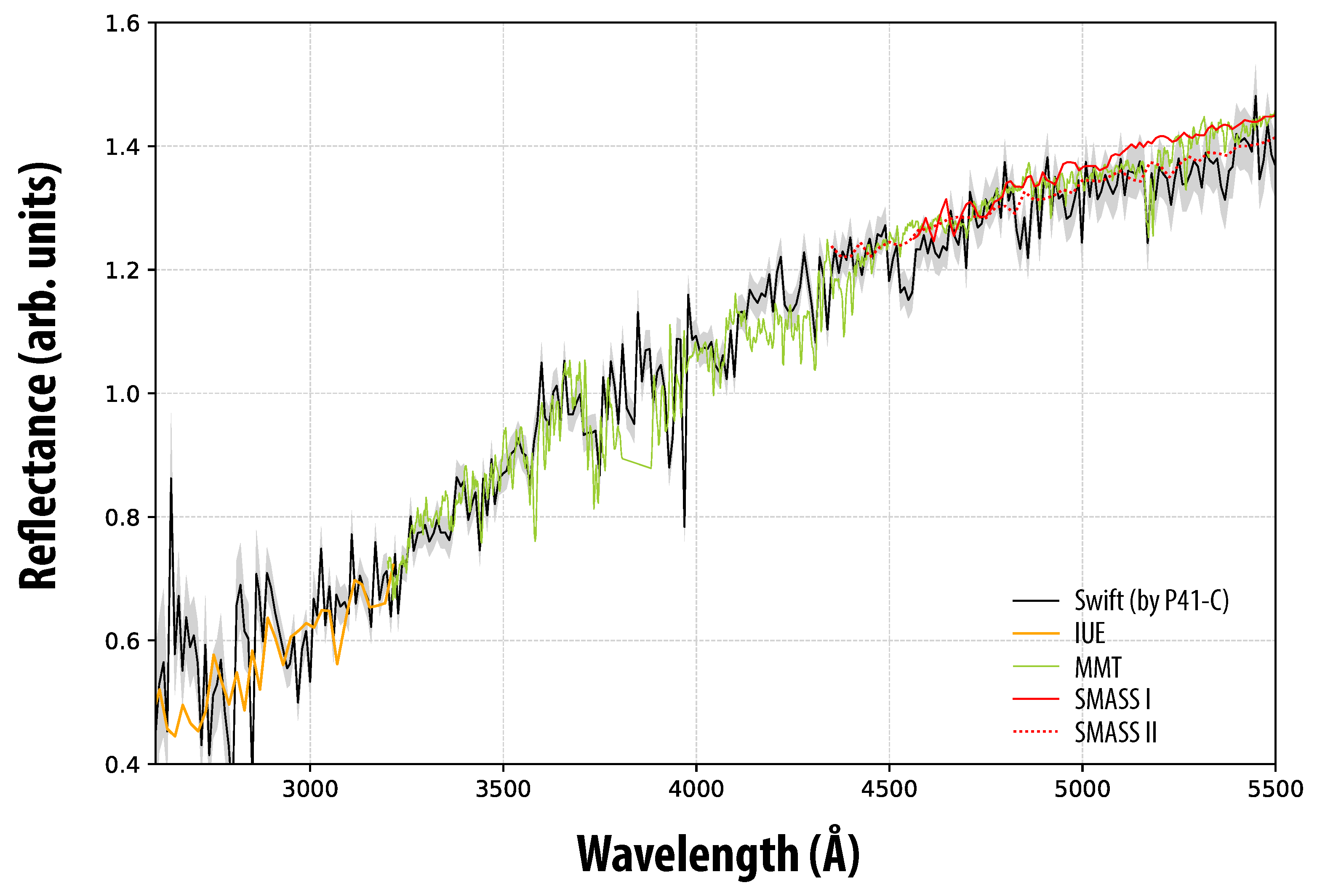
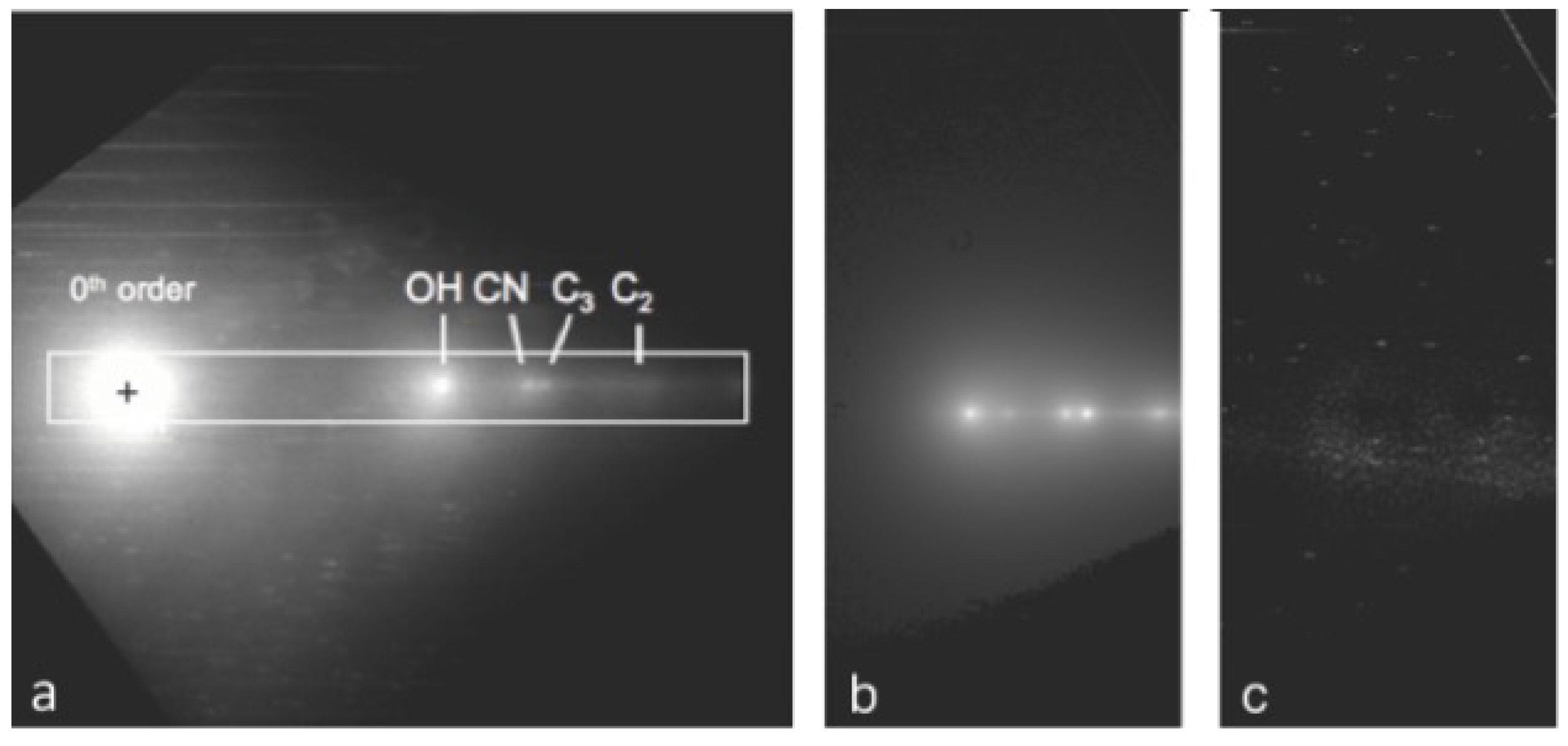
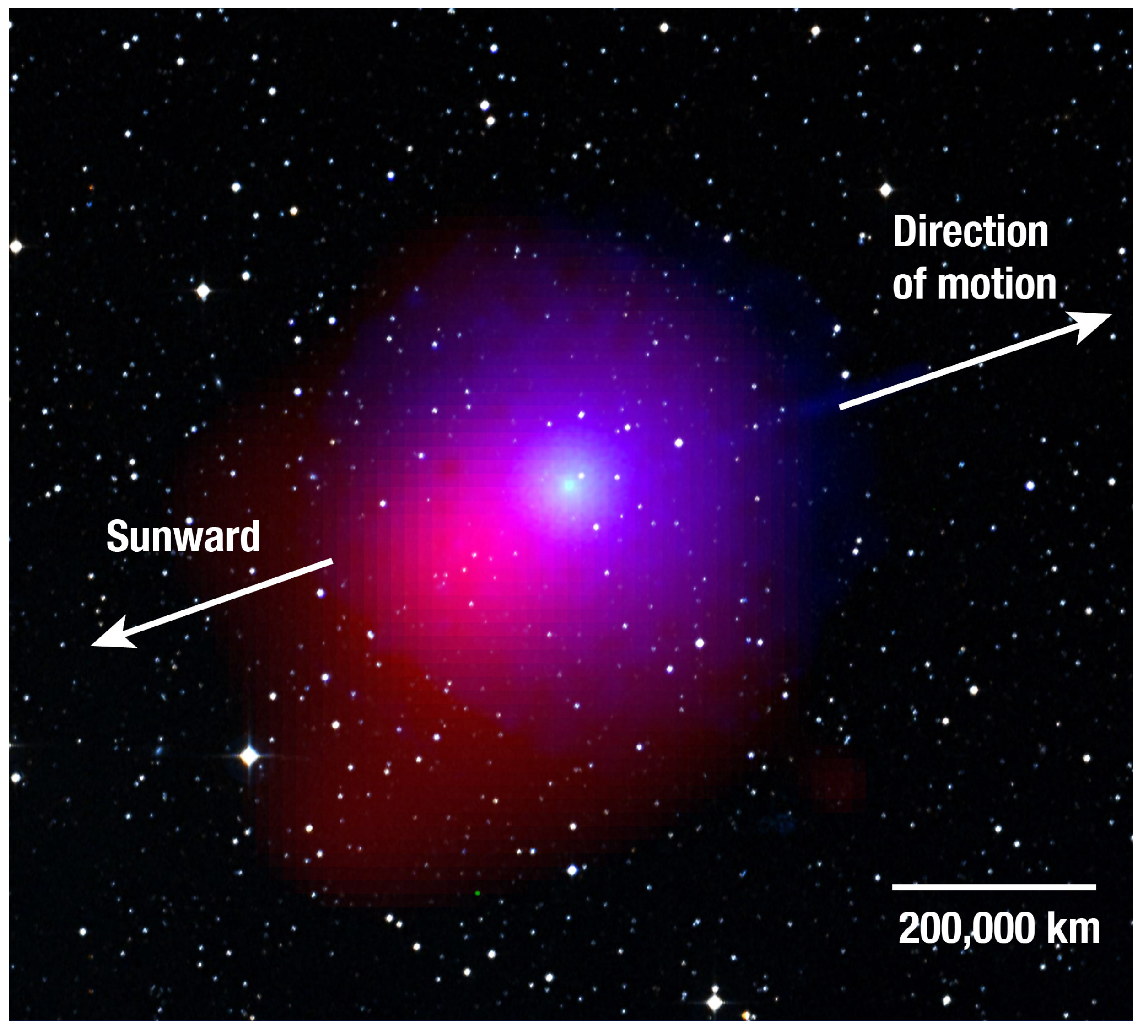
Disclaimer/Publisher’s Note: The statements, opinions and data contained in all publications are solely those of the individual author(s) and contributor(s) and not of MDPI and/or the editor(s). MDPI and/or the editor(s) disclaim responsibility for any injury to people or property resulting from any ideas, methods, instructions or products referred to in the content. |
© 2023 by the authors. Licensee MDPI, Basel, Switzerland. This article is an open access article distributed under the terms and conditions of the Creative Commons Attribution (CC BY) license (https://creativecommons.org/licenses/by/4.0/).
Share and Cite
Bodewits, D.; Xing, Z.; Saki, M.; Morgenthaler, J.P. Neil Gehrels–Swift Observatory’s Ultraviolet/Optical Telescope Observations of Small Bodies in the Solar System. Universe 2023, 9, 78. https://doi.org/10.3390/universe9020078
Bodewits D, Xing Z, Saki M, Morgenthaler JP. Neil Gehrels–Swift Observatory’s Ultraviolet/Optical Telescope Observations of Small Bodies in the Solar System. Universe. 2023; 9(2):78. https://doi.org/10.3390/universe9020078
Chicago/Turabian StyleBodewits, Dennis, Zexi Xing, Mohammad Saki, and Jeffrey P. Morgenthaler. 2023. "Neil Gehrels–Swift Observatory’s Ultraviolet/Optical Telescope Observations of Small Bodies in the Solar System" Universe 9, no. 2: 78. https://doi.org/10.3390/universe9020078
APA StyleBodewits, D., Xing, Z., Saki, M., & Morgenthaler, J. P. (2023). Neil Gehrels–Swift Observatory’s Ultraviolet/Optical Telescope Observations of Small Bodies in the Solar System. Universe, 9(2), 78. https://doi.org/10.3390/universe9020078




